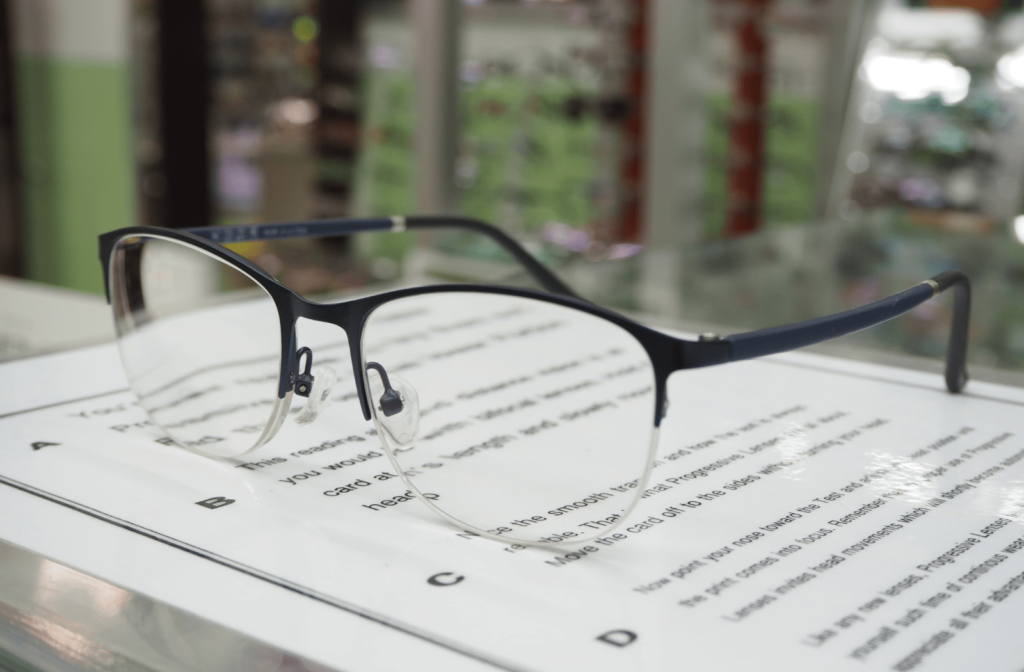Vision problems can happen to anyone—luckily, with the evolution of vision care technology, you have more options than ever. Staying consistent with your eye exams and updating your prescription are essential to finding the right lenses.
Progressive lenses are one of these evolutions in vision care that can polish your vision. Let’s look at what progressive lenses are, their primary function, and how to get used to them.
What Are Progressive Lenses?
Progressive lenses are a type of multifocal lens designed specifically for people who require corrective lenses to see distant and close-up objects.
Progressive lenses clear up your vision so you can see clearly at multiple distances.
As you age, the need for a progressive lens can increase, and by the age of 35 to 40, many people struggle with focusing their eyes on nearby objects. This vision issue is also known as presbyopia.
Progressive lenses are a convenient solution that offers a layered lens to simplify your age-related vision problems.
The progressive lens is structured as a gradual transition in strength:
- The upper section provides the strength you need to see clearly at a distance.
- The lower section provides the lens power to see clearly up close.
- The middle section combines both and helps you see clearly at intermediate or medium distances.
While primarily for people as they age, progressive lenses are also an option for children.
Pros & Cons of Progressive Lenses
Progressive lenses are a great option to combat various vision issues and come with pros and cons.
Some pros of progressive lenses:
- One pair of eyeglasses for daily use
- No distracting bifocal line
- Modern, customized glasses
Progressive lenses correct nearsightedness and farsightedness and can also be used to combat astigmatism or blurry vision.
While progressive lenses offer various benefits, it’s important to look at some of the cons as well.
Some cons of progressive lenses:
- It can take time to adjust
- Visual distortions
- Higher cost than single-vision and bifocal lenses
Progressive lenses can take time to get used to, and along with visual distortions during the adjustment process, the higher cost can discourage some people as well.
All-in-one progressive lenses don’t have a visible line to guide you. The absence of this visible line means you’ll have to train your eyes to look through the correct portion of the lens for whatever task you’re performing.
With the pros and cons explored, let’s look at the adjustment process when switching to progressive lenses.
How Do Progressive Lenses Work?
Progressive lenses, also known as multifocal lenses, are designed to provide a seamless transition between different vision distances. These lenses are primarily used to correct presbyopia, a common condition that affects individuals as they age and leads to a loss of near vision clarity.
Progressive lenses incorporate multiple focal points within a single lens, allowing wearers to see clearly at various distances without the need to switch between different pairs of glasses. The lens surface is divided into different zones, each with a specific power that gradually changes from the top to the bottom.
As a result, the top portion of the lens is optimized for distance vision, while the middle and lower portions correct for intermediate and near vision, respectively. This gradual power change enables a smooth and natural transition for wearers as they shift their gaze between different distances, providing clear vision at all focal points.

Getting Used to Progressive Lenses
Although progressive lenses are a great combination to see near and far distances clearly, these lenses aren’t the right choice for everyone. Progressive lenses can be difficult to get used to initially, and you may experience distortion in your vision until you get used to them.
It can take anywhere between a week to a couple of months to adapt and get used to progressive lenses. Getting your lenses customized and fitted by your optometrist can help accelerate the adjustment period along with wearing them as often as possible.
While getting used to your new progressive lenses, you may experience eye strain or headaches as your eyes adjust to the lens. This process is normal, and it’s okay to take breaks, but readjusting and trying again is advised to accelerate the adjustment process.
Getting into the habit of turning your head to look at objects instead of moving your eyes can help prevent distortion from peeking out the side of your glasses. While reading, it’s a different case as you’ll need to move your eyes instead.
Eyeglasses technology is constantly improving and developing, and progressive lenses are one of these innovations. Getting used to progressive lenses can be a lengthy process. Your optometrist can help you make any adjustments you need.
Clearing up Your Vision
Your eyes are complex, and vision care is essential. Progressive lenses are just one of the many new eye care technology methods to help you achieve your ideal vision. Finding a new pair of frames and clearing up your vision is more achievable than ever.
Book an appointment with your optometrist for more information and get your pair of progressive lenses today.




